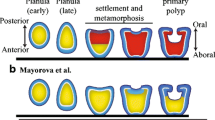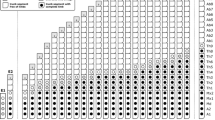Abstract
We investigated the development of Aurelia (Cnidaria, Scyphozoa) during embryogenesis and metamorphosis into a polyp, using antibody markers combined with confocal and transmission electron microscopy. Early embryos form actively proliferating coeloblastulae. Invagination is observed during gastrulation. In the planula, (1) the ectoderm is pseudostratified with densely packed nuclei arranged in a superficial and a deep stratum, (2) the aboral pole consists of elongated ectodermal cells with basally located nuclei forming an apical organ, which is previously only known from anthozoan planulae, (3) endodermal cells are large and highly vacuolated, and (4) FMRFamide-immunoreactive nerve cells are found exclusively in the ectoderm of the aboral region. During metamorphosis into a polyp, cells in the planula endoderm, but not in the ectoderm, become strongly caspase 3 immunoreactive, suggesting that the planula endoderm, in part or in its entirety, undergoes apoptosis during metamorphosis. The polyp endoderm seems to be derived from the planula ectoderm in Aurelia, implicating the occurrence of “secondary” gastrulation during early metamorphosis.








Similar content being viewed by others
Reference
Ball EE, de Jong DM, Schierwater B, Shinzato C, Hayward DC, Miller DJ (2007) Implications of cnidarian gene expression patterns for the origins of bilaterality—is the glass half full or half empty? Integr Comp Biol 47:701–711
Berrill NJ (1949) Developmental analysis of scyphomedusae. Biol Rev Camb Philos Soc 24:393–410
Brusca RC, Brusca GJ (2003) Invertebrates. Sinauer, Sunderland
Burnett AL, Davis LE, Ruffing FE (1966) A histological and ultrastructural study of germinal differentiation of interstitial cells arising from gland cells in hydra viridis. J Morphol 120:1–8
Chen JY, Oliveri P, Gao F, Dornbos SQ, Li CW, Bottjer DJ, Davidson EH (2002) Precambrian animal life: probable developmental and adult cnidarian forms from Southwest China. Dev Biol 248:182–196
Chia FS, Bickell L (1978) Mechanisms of larval settlement and the induction of settlement and metamorphosis: a review. In: Chia F-S, Rice ME (eds) Settlement and metamorphosis of marine invertebrate larvae. Elsevier, New York, pp 1–12
Chia FS, Crawford BJ (1973) Some observations on gametogenesis, larval development and substratum selection of sea pen Ptilosarcus gurneyi. Mar Biol 23:73–82
Chia FS, Koss R (1979) Fine-structural studies of the nervous-system and the apical organ in the planula larva of the sea-anemone Anthopleura elegantissima. J Morphol 160:275–297
Chourrout D, Delsuc F, Chourrout P, Edvardsen RB, Rentzsch F, Renfer E, Jensen MF, Zhu B, de Jong P, Steele RE et al (2006) Minimal ProtoHox cluster inferred from bilaterian and cnidarian Hox complements. Nature 442:684–687
Darling JA, Reitzel AR, Burton PM, Mazza ME, Ryan JF, Sullivan JC, Finnerty JR (2005) Rising starlet: the starlet sea anemone, Nematostella vectensis. Bioessays 27:211–221
Dawson MN, Jacobs DK (2001) Molecular evidence for cryptic species of Aurelia aurita (Cnidaria, Scyphozoa). Biol Bull 200:92–96
de Jong DM, Hislop NR, Hayward DC, Reece-Hoyes JS, Pontynen PC, Ball EE, Miller DJ (2006) Components of both major axial patterning systems of the Bilateria are differentially expressed along the primary axis of a ‘radiate’ animal, the anthozoan cnidarian Acropora millepora. Dev Biol 298:632–643
De Velasco B, Shen J, Go S, Hartenstein V (2004) Embryonic development of the Drosophila corpus cardiacum, a neuroendocrine gland with similarity to the vertebrate pituitary, is controlled by sine oculis and glass. Dev Biol 274:280–294
Fernando P, Kelly JF, Balazsi K, Slack RS, Megeney LA (2002) Caspase 3 activity is required for skeletal muscle differentiation. Proc Natl Acad Sci USA 99:11025–11030
Finnerty JR, Pang K, Burton P, Paulson D, Martindale MQ (2004) Origins of bilateral symmetry: Hox and dpp expression in a sea anemone. Science 304:1335–1337
Fioroni V (1979) Abändarungen des Gastrulationsverlaufs und ihre phylogenetische Bedeutung. In: Suewing R (ed) Erlanger Symp. Ontogenie Evolutionsforsch: Ontogenie unid Phylogenie. Parey, Hamburg, pp 100–119
Frank U, Leitz T, Muller WA (2001) The hydroid Hydractinia: a versatile, informative cnidarian representative. Bioessays 23:963–971
Freeman G (1981) The role of polarity in the development of the hydrozoan planula larva. Wilhelm Roux Arch Dev Biol 190:168–184
Freeman G (1983) Experimental studies on embryogenesis in hydrozoans (Trachylina and Siphonophora) with direct development. Biol Bull 165:591–618
Galliot B, Schmid V (2002) Cnidarians as a model system for understanding evolution and regeneration. Int J Dev Biol 46:39–48
Gershwin LA (2001) Systematics and biogeography of the jellyfish Aurelia labiata (Cnidaria: Scyphozoa). Biol Bull 201:104–119
Grimmelikhuijzen CJP (1983) Fmrfamide immunoreactivity is generally occurring in the nervous systems of coelenterates. Histochemistry 78:361–381
Groger H, Schmid V (2001) Larval development in Cnidaria: a connection to Bilateria? Genesis 29:110–114
Hyde JH (1894) Entwicklungsgeschichte einiger Scyphomedusen. Z Wiss Zool 58:531–565
Ishii H, Takagi A (2003) Development time of planula larvae on the oral arms of the scyphomedusa Aurelia aurita. J Plankton Res 25:1447–1450
Kamm K, Schierwater B, Jakob W, Dellaporta SL, Miller DJ (2006) Axial patterning and diversification in the Cnidaria predate the Hox system. Curr Biol 16:920–926
Lacalli TC (1994) Apical organs, epithelial domains, and the origin of the chordate central-nervous-system. Am Zool 34:533–541
Leitz T (1997) Induction of settlement and metamorphosis of Cnidarian larvae: signals and signal transduction. Invertebr Reprod Dev 31:109–122
Leitz T, Lay M (1995) Metamorphosin-a is a neuropeptide. Roux Arch Dev Biol 204:276–279
Magie CR, Daly M, Martindale MQ (2007) Gastrulation in the cnidarian Nematostella vectensis occurs via invagination not ingression. Dev Biol 305:483–497
Marlow HQ, Martindale MQ (2007) Embryonic development in two species of scleractinian coral embryos: symbiodinium localization and mode of gastrulation. Evol Dev 9:355–367
Martin VJ (1987) A morphological examination of gastrulation in a marine athecate hydrozoan. Biol Bull 173:324–334
Martin VJ (1991) Differentiation of the interstitial cell-line in hydrozoan planulae.1. Repopulation of epithelial planulae. Hydrobiologia 216:75–82
Martin VJ (2000) Reorganization of the nervous system during metamorphosis of a hydrozoan planula. Invertebr Biol 119:243–253
Martin VJ, Chia FS (1982) Fine-structure of a scyphozoan planula, Cassiopeia xamachana. Biol Bull 163:320–328
Martin VJ, Koss R (2002) Phylum cnidaria. In: Young CM (ed) Atlas of marine invertebrate larvae. Academic, San Diego, pp 51–108
Martin VJ, Littlefield CL, Archer WE, Bode HR (1997) Embryogenesis in hydra. Biol Bull 192:345–363
Martin V, Chia FS, Koss R (1983) A fine-structural study of metamorphosis of the hydrozoan Mitrocomella polydiademata. J Morphol 176:261–287
Martindale MQ (2004) The evolution of axial properties in the metazoa. Zool Sci 21:1233–1234
Matus DQ, Pang K, Marlow H, Dunn CW, Thomsen GH, Martindale MQ (2006) Molecular evidence for deep evolutionary roots of bilaterality in animal development. Proc Natl Acad Sci USA 103:11195–11200
Medina M, Collins AG, Silberman JD, Sogin ML (2001) Evaluating hypotheses of basal animal phylogeny using complete sequences of large and small subunit rRNA. Proc Natl Acad Sci USA 98:9707–9712
Mergner H (1971) Chapter 1: Cnidaria. In: Reverberi G (ed) Experimental embryology of marine and fresh-water invertebrates. North Holland, Amsterdam, pp 1–84
Miller DJ, Ball EE (2000) The coral Acropora: what it can contribute to our knowledge of metazoan evolution and the evolution of developmental processes. Bioessays 22:291–296
Muller WA, Wieker F, Eiben R (1976) Larval adhesion, releasing stimuli and metamorphosis. In: Mackie GO (ed) Coelenterate ecology and behavior. Plenum, New York, pp 339–346
Nakanishi N, Yuan D, Jacobs DK, Hartenstein V (2008) Early development, pattern and reorganization of the planula nervous system in Aurelia (Cnidaria, Scyphozoa). Dev Genes Evol (this issue)
Okada Y (1927) Note sur l’ontogenie de Carybdea rastonii Haacke. Bull Biol France et de la Belgique 2:241–248
Otto JJ (1978) The settlement of Haliclystus planulae. In: Chia FS (ed) ME rice settlement and metamorphosis of marine invertebrate larvae. Elsevier, New York, pp 13–22
Piatigorsky J, Kozmik Z (2004) Cubozoan jellyfish: an Evo/Devo model for eyes and other sensory systems. Int J Dev Biol 48:719–729
Plickert G (1989) Proportion-altering factor (Paf) stimulates nerve-cell formation in Hydractinia echinata. Cell Differ Dev 26:19–27
Plickert G, Kroiher M, Munck A (1988) Cell-proliferation and early differentiation during embryonic-development and metamorphosis of Hydractinia echinata. Development 103:795–803
Rentzsch F, Anton R, Saina M, Hammerschmidt M, Holstein TW, Technau U (2006) Asymmetric expression of the BMP antagonists chordin and gremlin in the sea anemone Nematostella vectensis: implications for the evolution of axial patterning. Dev Biol 296:375–387
Russell FS (1970) The medusae of the British Isles. Cambridge University Press, Cambridge
Ryan JF, Mazza ME, Pang K, Matus DQ, Baxevanis AD, Martindale MQ, Finnerty JR (2007) Pre-bilaterian origins of the Hox cluster and the Hox code: evidence from the sea anemone, Nematostella vectensis. PLoS ONE 2:e153
Schmich J, Trepel S, Leitz T (1998) The role of GLWamides in metamorphosis of Hydractinia echinata. Dev Genes Evol 208:267–273
Schroth W, Jarms G, Streit B, Schierwater B (2002) Speciation and phylogeography in the cosmopolitan marine moon jelly, Aurelia sp. BMC Evol Biol 2:1
Seipp S, Schmich J, Leitz T (2001) Morphogenesis of Cnidaria: programmed cell death during metamorphosis of Hydractinia echinata. Zoology (Jena) 103:13
Seipp S, Wittig K, Stiening B, Bottger A, Leitz T (2006) Metamorphosis of Hydractinia echinata (Cnidaria) is caspase-dependent. Int J Dev Biol 50:63–70
Slack JMW, Holland PWH, Graham CF (1993) The zootype and the phylotypic stage. Nature 361:490–492
Slautterback DB, Fawcett DW (1959) The development of the cnidoblasts of hydra—an electron microscope study of cell differentiation. J Biophys Biochem Cytol 5:441–452
Steele RE (2002) Developmental signaling in Hydra: what does it take to build a “simple” animal? Dev Biol 248:199–219
Steinberg SN (1963) Regeneration of whole polyps from ectodermal fragments of scyphistoma larvae of Aurelia aurita. Biol Bull 124:337–343
Szymczyk KH, Freeman TA, Adams CS, Srinivas V, Steinbeck MJ (2006) Active caspase-3 is required for osteoclast differentiation. J Cell Physiol 209:836–844
Wallberg A, Thollesson M, Farris JS, Jondelius U (2004) The phylogenetic position of the comb jellies (Ctenophora) and the importance of taxonomic sampling. Cladistics 20:558–578
Weis V, Buss L (1987) Ultrastructure of metamorphosis in Hydractinia echinata. Postilla 199:1–20
Widersten B (1968) On the morphology and development in some cnidarian larvae. Zool Bidrg Uppsala 37:139–182
Widersten B (1973) On the morphology of actiniarian larvae. Zool Sci 2:119–124
Wikramanayake AH, Hong M, Lee PN, Pang K, Byrum CA, Bince JM, Xu RH, Martindale MQ (2003) An ancient role for nuclear beta-catenin in the evolution of axial polarity and germ layer segregation. Nature 426:446–450
Yanze N, Spring J, Schmidli C, Schmid V (2001) Conservation of Hox/ParaHox-related genes in the early development of a cnidarian. Dev Biol 236:89–98
Zwilling E (1963) Formation of endoderm from ectoderm in cordylophora. Biol Bull 124:368–378
Acknowledgements
We thank Mike Schaadt and Kiersten Darrow of the Cabrillo Marine aquarium, San Pedro, CA, USA for providing us with the Aurelia material. This work was supported by the UCLA Edwin W. Pauley fellowship (to N.N.) and the NASA Astrobiology Institute. We also thank anonymous reviewers for helpful comments on the manuscript.
Author information
Authors and Affiliations
Corresponding author
Additional information
Communicated by M.Q. Martindale
Rights and permissions
About this article
Cite this article
Yuan, D., Nakanishi, N., Jacobs, D.K. et al. Embryonic development and metamorphosis of the scyphozoan Aurelia . Dev Genes Evol 218, 525–539 (2008). https://doi.org/10.1007/s00427-008-0254-8
Received:
Accepted:
Published:
Issue Date:
DOI: https://doi.org/10.1007/s00427-008-0254-8




